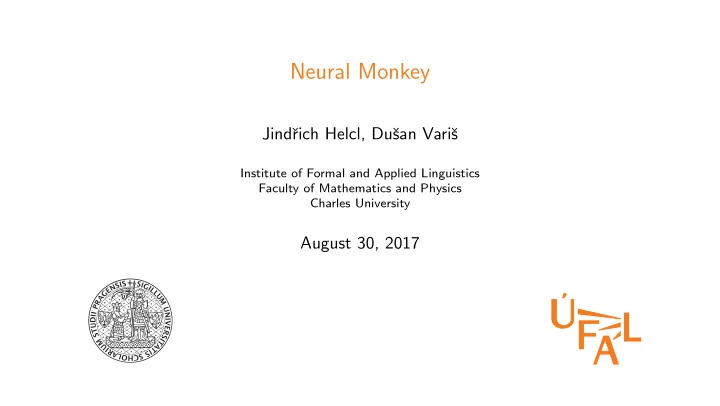

Neural Monkey Jindˇ rich Helcl, Duˇ san Variˇ s Institute of Formal and Applied Linguistics Faculty of Mathematics and Physics Charles University August 30, 2017
Outline Introduction General Architecture Configuration Files Getting Started Installation Simple Exercise Exercises
Neural Monkey • Toolkit for training neural models for sequence-to-sequence tasks • Implemented in Python 3 using Tensorflow 1.3 • GPU support using CUDA, cuDNN • Modular implementation of parts of computational graph → easy composition of new models • Applications in research [Kreutzer et al., 2017, Libovick´ y and Helcl, 2017]
Model Workflow Model Runners Input data Model outputs series1 Runner1 Postprocess output1 Encoder 1 output2 series1_prep Decoder 1 Runner2 output3 series2 output4 ... combined_2_X Runner3 ... Encoder 2 ... seriesX ... Decoder 2 Trainer vocabulary1 Encoder N vocabulary2 Figure 1: Model workflow. Each step of the workflow can be modified/expanded by changing a corresponding section in the model configuration file.
Configuration Files • Experiment specification: • model definition, training, inference • data location, preprocessing, output postprocessing • experiment metaparameters, evaluation metrics • INI file syntax • Sections defining separate objects • Key-value pairs separated by ’=’ • Values can be atomic (int, boolean, string) or composite (list, objects) • Sections are interpreted as Python dictionaries
Configuration Files ; configuration snippet example [main] name="example" tf_manager=<tf_manager> output="output/dir" batch_size=16 epochs=2 train_dataset=<train_data> val_dataset=<val_data> runners=[<runner>] evaluation=[("target", <bleu>)] [tf_manager] class=tf_manager.TensorFlowManager num_sessions=1 ; (...)
Installation 1. (Optional) Set up a Python virtualenv (with Python¿=3.5) 2. $ git clone https://github.com/ufal/neuralmonkey 3. $ cd neuralmonkey 4. $ pip install -r requirements.txt 5. $ ./run tests.sh # (Optional) Check the installation
Running the Monkey • Training: bin/neuralmonkey-train <experiment config> • e.g. bin/neuralmonkey-train tests/small.ini • Running the model: bin/neuralmonkey-run <experiment config> <data config> • e.g. bin/neuralmonkey-run tests/small.ini tests/test data.ini • experiment config can be the same file that was used during traning • data config specifies the dataset for the inference and (if on non-default location) variable files to load the model from
Exercises: Directory Structure • Configuration files: ∼ /experiments • Experiment data: ∼ /data • Experiment output: ∼ /experiments/<experiment name>
Exercises: Prepared Config Files • Machine Translation: ∼ /experiments/translation.ini • Text Summarization: ∼ /experiments/summarization.ini •
Exercises: Modifying the Experiments Choose a task from previous slide and try changing the existing config file. 1. Run the task on character-level architecture. Use neuralmonkey.processors.helpers classes to pre/postprocess the input senten 2. Use two encoders (with a similar architecture) to encode both word representation and character representation of the sentence. 3. Replace the GreedyRunner by BeamSearchRunner, and Decoder by BeamSearchDecoder. 4. Use different encoder (see neuralmonkey/encoders for possible substitutes).
Recommend
More recommend